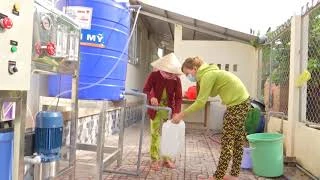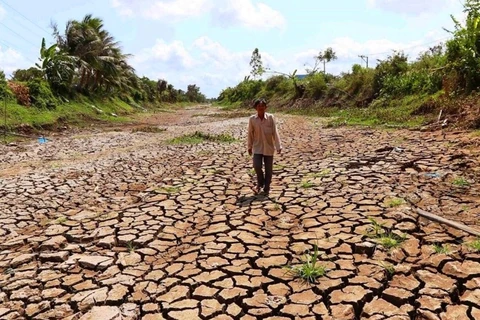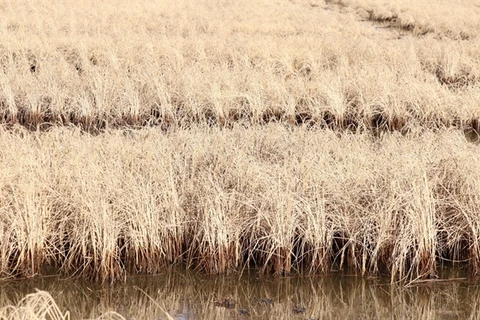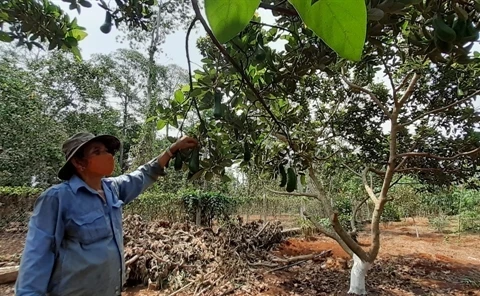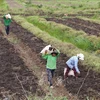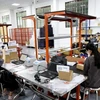HCM City (VNS/VNA) - Many fruit farmers in the Mekong Delta have suffered losses this year due to crop failure caused by drought and saltwater intrusion and lower demand for fruits.
Nguyen Ngoc Nhan, a rambutan grower in Binh Hoa Phuoc commune in Vinh Long province’s Long Ho district, said his commune has never suffered from salinity intrusion in the past, but this year water in canals have 0.3-0.4 percent salt content.
Facing a freshwater shortage, farmers had to irrigate their orchards with water from canals, which caused their rambutan trees to wither and shed their leaves, he said.
Nhan said during the last harvest, rambutan prices dropped by nearly 9,000 VND per kilogramme to 6,000 VND, causing farmers like him to suffer huge losses.
According to the commune People’s Committee, by early May salinity had affected 478ha of orchards, including 28ha of durian, 379ha of rambutan and over 70ha of longan.
Saltwater affected 95 percent of lands in the commune, causing estimated losses of more than 11 billion VND (nearly 500,000 USD).
Farmers on Tan Quy island (in An Phu Tan commune of Tra Vinh province’s Cau Ke district) were also affected by drought and salinity.
The commune People’s Committee said around 250ha of orchards, mainly rambutan, were affected.
Nguyen Van Tri, a farmer on Tan Quy island, said: “This year I grew rambutan trees on 1ha. But its yield was poor because the orchard was irrigated with saltwater which had intruded into rivers and canals in the area.”
According to figures from the Cho Lach District Division of Agriculture and Rural Development, some 1,600ha of durian, rambutan and other fruits were affected by saltwater. Of this, 240ha was fully destroyed, 720ha suffered 50-70 percent damage, 240ha suffered 30-50 percent damage, and 400ha lost up to 30 percent.
Nguyen Van Tuan, a farmer in Tan Phu commune in Ben Tre province’s Chau Thanh district, said hundreds of 15-year-old durian trees in his orchards have withered.
Each used to produce some 120 fruits every year, and with the fruits selling at 55,000-60,000 VND per kilogramme, he would earn over 20 million VND (over $900) per tree per year, he added.
Falling fruit prices, low demand
According to fruit buyers in HCM City, fruits such as longan, plum, rambutan, and durian are being sold now at 50 to 70 percent of last year’s prices.
Longan is sold at 20,000 VND per kilogramme, Hoa Loc mango at 25,000 VND and rambutan at 30,000-40,000 VND and Thai rambutan at 50,000 VND for three kilogrammes.
According to a manager at the Thu Duc Wholesale Market, though it is fruit harvest time, the volumes coming to his market were not large due to low demand.
He said only 1,400 tonnes are brought in daily, 400 tonnes less than a year ago. Around 320 tonnes of litchi come from northern provinces, only half of last years’ figure, he said.
The fruit sells for just 25,000 VND this year, he added./.
Nguyen Ngoc Nhan, a rambutan grower in Binh Hoa Phuoc commune in Vinh Long province’s Long Ho district, said his commune has never suffered from salinity intrusion in the past, but this year water in canals have 0.3-0.4 percent salt content.
Facing a freshwater shortage, farmers had to irrigate their orchards with water from canals, which caused their rambutan trees to wither and shed their leaves, he said.
Nhan said during the last harvest, rambutan prices dropped by nearly 9,000 VND per kilogramme to 6,000 VND, causing farmers like him to suffer huge losses.
According to the commune People’s Committee, by early May salinity had affected 478ha of orchards, including 28ha of durian, 379ha of rambutan and over 70ha of longan.
Saltwater affected 95 percent of lands in the commune, causing estimated losses of more than 11 billion VND (nearly 500,000 USD).
Farmers on Tan Quy island (in An Phu Tan commune of Tra Vinh province’s Cau Ke district) were also affected by drought and salinity.
The commune People’s Committee said around 250ha of orchards, mainly rambutan, were affected.
Nguyen Van Tri, a farmer on Tan Quy island, said: “This year I grew rambutan trees on 1ha. But its yield was poor because the orchard was irrigated with saltwater which had intruded into rivers and canals in the area.”
According to figures from the Cho Lach District Division of Agriculture and Rural Development, some 1,600ha of durian, rambutan and other fruits were affected by saltwater. Of this, 240ha was fully destroyed, 720ha suffered 50-70 percent damage, 240ha suffered 30-50 percent damage, and 400ha lost up to 30 percent.
Nguyen Van Tuan, a farmer in Tan Phu commune in Ben Tre province’s Chau Thanh district, said hundreds of 15-year-old durian trees in his orchards have withered.
Each used to produce some 120 fruits every year, and with the fruits selling at 55,000-60,000 VND per kilogramme, he would earn over 20 million VND (over $900) per tree per year, he added.
Falling fruit prices, low demand
According to fruit buyers in HCM City, fruits such as longan, plum, rambutan, and durian are being sold now at 50 to 70 percent of last year’s prices.
Longan is sold at 20,000 VND per kilogramme, Hoa Loc mango at 25,000 VND and rambutan at 30,000-40,000 VND and Thai rambutan at 50,000 VND for three kilogrammes.
According to a manager at the Thu Duc Wholesale Market, though it is fruit harvest time, the volumes coming to his market were not large due to low demand.
He said only 1,400 tonnes are brought in daily, 400 tonnes less than a year ago. Around 320 tonnes of litchi come from northern provinces, only half of last years’ figure, he said.
The fruit sells for just 25,000 VND this year, he added./.
VNA


